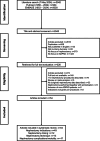Nephrectomy in autosomal dominant polycystic kidney disease: a consensus statement of the ERA Genes & Kidney Working Group
- PMID: 39848914
- PMCID: PMC12209818
- DOI: 10.1093/ndt/gfaf019
Nephrectomy in autosomal dominant polycystic kidney disease: a consensus statement of the ERA Genes & Kidney Working Group
Abstract
A substantial number of patients with autosomal dominant polycystic kidney disease (ADPKD) undergo a nephrectomy, especially in workup for a kidney transplantation. Currently, there is no evidence-based algorithm to guide clinicians about which patients should undergo nephrectomy, the optimal timing of this procedure, or the preferred surgical technique. This systematic review-based consensus statement aimed to answer important questions regarding nephrectomy in ADPKD. A literature review was performed and extended to a meta-analysis when possible. For this purpose, PubMed and EMBASE were searched up to May 2024. Fifty-four publications, describing a total of 2391 procedures, were included. In addition, an exploratory questionnaire was sent to urologists, nephrologists, and transplant surgeons. These sources were used to develop practice points about indications, complications, mortality, and timing and technique of nephrectomy. In addition, data on renal embolization as a potential alternative to nephrectomy were explored and summarized. To reach consensus, practice points were defined and improved in three Delphi survey rounds by experts of the European Renal Association Working Group Genes & Kidney and the European Association of Urology Section of Transplantation Urology. A total of 23 practice points/statements were developed, all of which reached consensus. Among others, it was deemed that nephrectomy can be performed successfully for various indications and is an intermediate risk procedure with acceptable mortality and minimal impact on kidney graft function when performed before, in the same session or after transplantation. The complication rate seems to increase when the procedure is performed as an emergency. During the workup for transplantation, patient complaints should be assessed routinely by questionnaires to indicate symptom burden. Deciding on the need for nephrectomy and exploring potential alternatives such as kidney embolization should be a process of shared decision-making, preferably after multidisciplinary consultation.
Keywords: ADPKD; kidney transplantation; nephrectomy; polycystic kidney disease.
© The Author(s) 2025. Published by Oxford University Press on behalf of the ERA.
Conflict of interest statement
All authors stated that they did not have conflicts of interest for this specific article.
Figures








